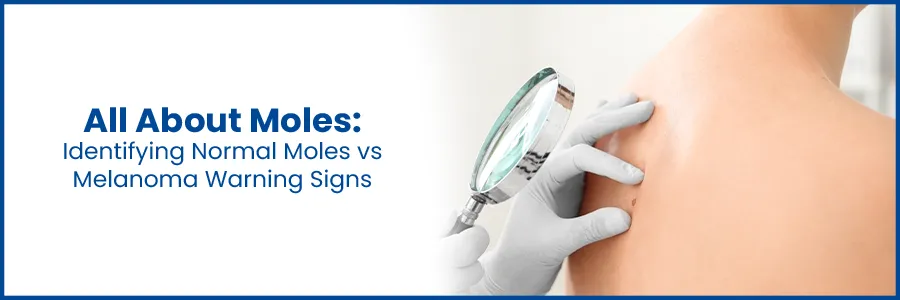
All About Moles: Normal Moles vs. Melanoma Warning Signs
Moles are a common feature of our skin, but understanding the distinction between harmless moles and potential indicators of melanoma, a dangerous form of skin cancer, is crucial. This comprehensive guide explores the world of moles, including what constitutes a normal mole, and provides essential insights to identify melanoma warnings. By familiarizing yourself with these signs, you empower yourself with knowledge that could potentially save lives.
Understanding Moles:
Moles, or nevi, are clusters of pigmented cells that can emerge anywhere on the body. Ranging in size, shape, and color, most moles are benign. They can either be present from birth or develop over time due to genetic predisposition or sun exposure.
Different Types of Moles:
Moles come in various types, including junctional, compound, and dermal moles. While these are generally harmless, one type requires special attention: dysplastic nevi. These moles exhibit irregular shapes and colors and are considered a risk factor for melanoma.
Secure your health with a second opinion. Make informed decisions and book your appointment today!
Get A Second OpinionMelanoma, the Deadliest Type of Skin Cancer:
Melanoma originates in the melanocytes, cells responsible for producing pigment. It's crucial to recognize any potential melanoma warning signs because doing so dramatically improves the likelihood of successful treatment.
Recognizing Melanoma Warning Signs:
The mnemonic "ABCDE" helps identify melanoma warning signs:
- Asymmetry : One half of the mole differs from the other half.
- Border Irregularity : The edges are uneven, notched, or blurred.
- Color : Uneven colors, including shades of brown, black, red, white, or blue.
- Diameter : The mole is about the size of a pencil eraser and has a diameter larger than 6 millimeters, or 1/4 inch.
- Evolution : Changes in size, shape, or color over time.
Self-Examinations and Professional Check-Ups:
Frequent self-examinations are crucial to notice any mole changes. If a mole fits the ABCDE criteria or raises concerns, consult a dermatologist. Professional evaluations may include biopsies if necessary.
Prevention and Protection:
While some melanoma risk factors are uncontrollable (like genetics), we can take steps to lower our risk. Sun protection is paramount. Employ broad-spectrum sunscreen, wear protective clothing, and minimize sun exposure, especially during peak hours.
Conclusion: Nurturing Your Skin's Well-Being:
Moles are a natural part of our skin, but recognizing potential melanoma warnings is essential. Regular self-examinations, coupled with professional evaluations, provide the best defense against melanoma's risks. By staying informed and proactive, you cultivate a healthy relationship with your skin, ensuring it remains a canvas of well-being for years ahead.
Secure your health with a second opinion. Make informed decisions and book your appointment today!
Book an AppointmentFrequently Asked Questions
Moles, or nevi, are clusters of pigmented cells on the skin. They can appear due to a combination of genetic factors and sun exposure over time.
Using the "ABCDE" rule can help distinguish between normal moles and potential melanoma: A for asymmetry, B for irregular borders, C for varied color, D for larger than a pencil eraser in diameter, and E for evolution or changes in size, shape, or color.
No, most moles are harmless and do not pose a risk. However, it's essential to be aware of any changes in size, shape, or color and to consult a dermatologist if you see any concerning features.
Melanoma is primarily caused by excessive UV exposure, either from the sun or tanning beds. Individuals with fair skin, a history of sunburns, family history of skin cancer, or numerous atypical moles are at higher risk.
Despite the fact that melanoma is more common in older people, it can occur at any age, including childhood. Parents should be vigilant about changes in their children's moles and skin.
It's common for moles to change slightly, especially during puberty and pregnancy. However, significant changes in size, shape, color, or texture should be examined by a dermatologist.
Melanoma may appear anywhere on the body, but most frequently affects skin exposed to the sun, such as the face, neck, arms, and back.
Yes, adopting sun-safe practices can reduce your risk. Use broad-spectrum sunscreen, wear protective clothing, avoid excessive sun exposure, and perform regular self-checks for changes in moles.
A dermatologist will visually inspect your moles and might use a dermatoscope, a tool that magnifies the mole's features. If a mole looks suspicious, a biopsy might be recommended for further evaluation.
Regular self-examinations are crucial. Aim to check your moles every few months, and keep an eye out for any changes in size, shape, color, or texture.
Not all changes indicate melanoma, but any significant changes warrant a professional evaluation. Early detection is key to successful treatment.
Yes, when detected and treated early, melanoma is highly treatable. Surgical removal is the primary treatment method. More advanced cases may require additional treatments, such as chemotherapy or immunotherapy.
